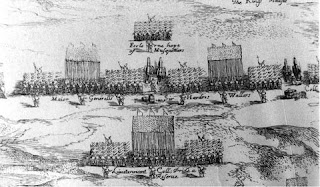Wednesday, 8 May 2024
Backs (or flank) against the wall, Heavenfield, 633 CE
Sunday, 30 October 2022
Wolseley versus Arabi Pasha, 1882: HotE in 6mm
Exploring how I might use the Wargames Research Group fantasy rules, Hoards of the Things, has been on my to-do list for years, nay, decades! There is an active Facebook group and WRG released a second edition in 2002. There is talk of 2.1 being out there but I have yet to track a set down.
While the fantasy setting has some interest to me as an another option for gaming in the style of Osprey’s Of Gods and Mortals, the adaptations of HOTT:
1. Hordes of the Empire (HotE): the Victorian colonial Mr wars adaptation of HOTT by Paul Potter, Blake Radetzky and Terry Webb.
HotE and related resources can be obtained through the DBA & HOTT Wargaming Facebook group. If I find a reliable web link I will update this post.
2. Hoards in the Trenches: the Great War version by Matt Kirkhart.
There are some (somewhat questionable) downloadable versions of HitT for those Google savvy types among you, the only link I feel comfortable advertising is the v.5 http://ianjgow.blogspot.com/p/hordes-in-trenches.html?m=1
To that end, my first project for HotE will be the Anglo-Egyptian war of 1882. I came separately, rather surprisingly, to the same view as Featherstone that Lieutenant-General Wolseley’s 1882 expedition to overthrow the dictator Said Ahmed Arabi foreshadows the British expedition to the Falkland Islands to eject the Argentinian junta one hundred years later (Featherstone, Tel El Kabir 1882, Osprey Campaign 27).
Both campaigns lasted four and a half weeks and, due to logistical constraints, required the British to deploy their crack regular regiments not normally used for these purposes. While in wargaming terms the engagements are a little unbalanced, the variety of units on both sides make for a fun miniatures project - household cavalry, armoured trains, the Naval Brigade, Egyptian veterans redrafted into service, Sudanese conscripts, Bedouins, Krupp ordinance!
There are no doubt some great new lines in 6mm Colonial miniatures out there - more-so with the growth of 3-D printed options - but I am an avowed metal figure gamer and rusted-on (or the non-ferrous equivalent) user of Irregular Miniatures. https://www.irregularminiatures.co.uk/6mmRanges/6mmColonial.htm
In typical fashion, I rushed into the first set of elements, probably sacrificed the paint job a bit and went with what I had for basing - I may add some detail later - but here they are (With HotE/HOTT descriptors):
 |
| Egyptian/ Sudanese lancers would be classified as ‘Riders’ in the HotE Egyptian 1882 army list. |
 |
| A Bashi ‘Hoard’ (back left), two Sudanese ‘shooters’ (centre) and Bashi-Bazook ‘riders’ (right). |
 |
| Egyptian infantry in foreground (Shooters) |
 |
| 3 bases of Krupp artillery (foreground) and the ‘General’ in the centre. The army list only calls for 1 artillery base but given there were 75 Egyptian guns at Tel El-Kabir, I upped the numbers! |
 |
| Another shot of the ordinance - I’m a gunner at heart! |
 |
| Another shot of the irregular infantry |
 |
| ‘Lurkers’ Bashi-Bazook skirmishers |
 |
| The Egyptian army of the Arabi Pasha mustered |
Saturday, 28 September 2019
2mm ACW (with updates)
Update: I have since discovered that the rules are part of a collected set by John Bobek, The Games of War: A Treasury of Rules for Battles with Toy Soldiers, Ships and Planes (2007): https://boardgamegeek.com/boardgame/37718/games-war-treasury-rules-battles-toy-soldiers-ship A copy is on its way in the next week or two! I will review the rules in more detail then.
The mechanics of movement, shooting, melee and morale are provided but the set lacks a turn sequence and the morale rules are a bit unclear - but the rest is solid. I’m playing through a game to the identify gaps and will write up some homegrown solutions.
Update: thanks for a Review by Ryan Morgan on the above BGG page, I have learned that 'In chapter one Mr. Bobek lays out the ground work for interpreting his rules in the further chapters as well as discusses his philosophy for wargaming.'
At this point I just wanted to post some shots of the initial few turns and I will update on my thoughts soon. This blog has been quiet for too long!
I’ve also been experimenting with creating woods terrain for 2mm using Casuarina cones coated in flock - there are some WIP images below. I'll post a short tutorial next.
Sunday, 1 April 2018
Thirty Years War in 2mm - basing using 17th century military texts
For instance, for the 2mm enthusiast I thoroughly recommend a wander around Sydney Roundwood's blog (Roundwood's World) and check out his wonderful Lützen (1632) and Nördlingen (1634) projects in 2mm. I liked the result so much, I have shamelessly copied the winter basing Sydney has used. After all, Imitation is the sincerest form of flattery that mediocrity can pay to greatness!
 |
| What I love about 2mm as a scale, one small bag contains a few weekends of work! |
 |
| Hmmmm. So, what to do with them... |
 While in many cases the deployments of foot troops discussed in these manuals tend towards the theoretical rather than actually reflecting those used in the field, it helped me better understand the texts and posed interesting challenges in working with the blocks and the space available on the base.
While in many cases the deployments of foot troops discussed in these manuals tend towards the theoretical rather than actually reflecting those used in the field, it helped me better understand the texts and posed interesting challenges in working with the blocks and the space available on the base.Overall, the main Irregular Miniatures blocks I used for these bases were:
- RBG7, 45 figure 1-2 pike/shot unit (15 pike/30 shot);
- RBG12, 3-rank Forlorn Hope - 15 figures;
- RBG33, 15 figure Pike block;
- RBG25 Command - 2 figures;
- RBG9, Swiss/Landsknecht pike unit (40 pikes);
- BG2, Infantry in three ranks (24 figures) (these are from the Horse and Musket range; but make great musket units);
- Oh, and of course, the Tercio! - RBG10, Tercio (100 figures 40 pike/60 shot).
My basing scheme is using a 50mm x 25mm bases (c. 2"x1") for foot and cavalry with each foot base being a regiment and each cavalry base a squadron. Command and artillery (and possibly detachments of shot) will be on 25 x 25mm (c. 1" x 1") bases. So, basically, a scaled down Polemos basing system.
 |
| All three squadrons deployed in the style of the Swedish Brigade. |
Monday, 19 February 2018
2mm ACW ... progress!
Nevertheless, every project gets its moment in the sun, and 2mm ACW seems to be having just that. Besides, I want to start a Thirty Years War project in 2mm so it was time to get a wriggle on.
So, after a flurry this weekend painting is nearly complete and I am now working on basing (40x20mm). For me, one of the challenges with 2mm basing is to ensure they help show the direction the blocks are facing (very helpful with my dodgy eyesight).
I am working on some subtle 'landscaping' on each base with gravel, static grass and minute pieces of clump foliage. At this scale even the finest gravel looks like I'm recreating the Devil's Den! So some subtlety is required (in short supply here).
I can feel the project nearing the point where I can game with them (if I could only settle on a set of rules*!). In the meantime, I couldn't resist a quick layout for some pictures. I think the pictures show that 2mm - even with fairly rudimentary basing and paintwork can give a really good drones-eye view of civil war engagements!
*which will, of course, need to be sympathetic with my rather arbitrary decisions around basing!
Monday, 12 February 2018
2mm ACW is back on the table!
I've grasped the nettle and based them on a 40mm x 20mm (1 1/2" x 7/16") with two infantry blocks on each. I've been experimenting with adding a little detail to the base - in this case, the muddy path across the field left by the companies as they advance.
I'll look at adding some bushes and hopefully a fence or two (pebbles for stone or flywire for post and rail).
The 2mm project lives!
Sunday, 8 February 2015
2mm ACW – rebasing
I was struggling with the need to amalgamate smaller brigades / demi bridges / reserves into roughy equal strength groups in CoA. I would find myself having to amalgamate smaller formations that were not deployed anywhere hear each other.
So, I have rebased to 40mmx 20mm which fits two regiments on it nicely allowing 2–3 base brigades. and is a fairly adaptable format in terms of use with a variety of rulesets. CoA is being set aside for this project and I'm going to trial Polemos On They Come and DBACW (which I've played before and quite like).
With a flurry of activity over the past day, the Union have the best part of a Corps nearly ready for the field as well and the CSA are rebased as well. One of the great joys of 2mm is the relative speed in which you can paint them.
Here's the days effort:
 |
| Re-based Confederates |
 |
| The Federalists finally make an appearance! |
 |
| All together with a few command and artillery stands in half size. |



































